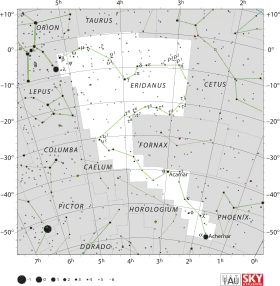 | |
| Observation data Epoch J2000 Equinox J2000 | |
|---|---|
| Constellation | Eridanus |
| Right ascension | 04h 14m 04.867s[1] |
| Declination | −31° 55′ 22.36″[1] |
| Apparent magnitude (V) | 11.51[2] |
| Astrometry | |
| Proper motion (μ) | RA: 12.082[3] mas/yr Dec.: 9.513[3] mas/yr |
| Parallax (π) | 1.6861 ± 0.4296 mas[3] |
| Distance | 1900±225 ly (584±70[4] pc) |
| Details[4] | |
| System | |
| Age | 3.160±0.624 Gyr |
| A1 | |
| Mass | 1.25±0.05 M☉ |
| Radius | 1.49±0.07 R☉ |
| Luminosity | 3.39 L☉ |
| Surface gravity (log g) | 4.18 cgs |
| Temperature | 6,400±125 K |
| Rotational velocity (v sin i) | 48.5 km/s |
| A2 | |
| Mass | 0.56±0.04 M☉ |
| Radius | 0.52±0.04 R☉ |
| Luminosity | 0.07 L☉ |
| Surface gravity (log g) | 4.73 cgs |
| Temperature | 3,923±100 K |
| Rotational velocity (v sin i) | 17.5 km/s |
| B1 | |
| Mass | 1.30±0.08 M☉ |
| Radius | 1.69±0.22 R☉ |
| Luminosity | 3.95 L☉ |
| Surface gravity (log g) | 4.12 cgs |
| Temperature | 6,365±170 K |
| Rotational velocity (v sin i) | 10.1 km/s |
| B2 | |
| Mass | 0.66±0.03 M☉ |
| Radius | 0.62±0.02 R☉ |
| Luminosity | 0.12 L☉ |
| Surface gravity (log g) | 4.67 cgs |
| Temperature | 4,290±110 K |
| Rotational velocity (v sin i) | 3.8 km/s |
| C1 | |
| Mass | 1.23±0.10 M☉ |
| Radius | 1.45±0.28 R☉ |
| Luminosity | 2.74 L☉ |
| Surface gravity (log g) | 4.24 cgs |
| Temperature | 6,350±160 K |
| Rotational velocity (v sin i) | 51.5 km/s |
| C2 | |
| Mass | 0.59±0.07 M☉ |
| Radius | 0.56±0.07 R☉ |
| Luminosity | 0.07 L☉ |
| Surface gravity (log g) | 4.72 cgs |
| Temperature | 3,889±190 K |
| Rotational velocity (v sin i) | 20.9 km/s |
| Other designations | |
| Database references | |
| SIMBAD | data |
TIC 168789840, also known as TYC 7037-89-1,[5] is a stellar system with six stars.[6][4] Three pairs of binary stars circle a common barycenter. While other systems with three pairs of stars have been discovered, this was the first system where the stars can be observed eclipsing one another, as their planes of rotation point approximately towards the Earth.[5]
Discovery
.png.webp)
The Transiting Exoplanet Survey Satellite identified that the star system consisted of six eclipsing stars.[7] The discovery was announced in January 2021. It is approximately 1,900 light-years (584 pc) from Earth, in the constellation Eridanus, west of the river asterism's sharpest bend, Upsilon2 Eridani, often called Theemin.[8] To be seen the group needs strong magnification from Earth as is much fainter than red clump giant star Theemin and is about nine times further away.
Orbits

Two sets of the binaries co-orbit relatively closely, while the third pair of stars takes 2,000 years to orbit the entire system barycenter.[6][10][11] The inner A pair and C pair orbit each other in 3.7 years. These are, as taken from the paired B stars, about 250 AU away (specifically the mean telescopic separation is 423 mas) and the three lettered pairs, as groups, have been resolved (the three gaps made out). From A pair to C pair is calculated to be 4 AU (∼7 mas) apart, which means this gap should be resolvable using speckle interferometry which has not yet been achieved.
Note, the three binaries (here close pairs) A, B, and C are resolved only as systems, the pairs being just 6.9 R☉ (∼0.054 mas), 21.4 R☉ (∼0.168 mas), and 6.1 R☉ (∼0.047 mas) apart, respectively.[4]
According to Jeanette Kazmierczak of NASA's Goddard Space Flight Center:
|
Stellar characteristics
The primary stars of all three close binaries are slightly hotter and brighter than the Sun,[7] while the secondary stars are much cooler and dimmer.[4] Because the two closely bound pairs are so close, only the third, more distant pair could have planets.[6] The primaries are all beginning to evolve away from the main sequence, while the less massive and longer-lived secondaries are all still firmly on the main sequence and fusing hydrogen in their cores.[4]
See also
- Castor (star) – the second-brightest (apparent) "star" in Gemini, likewise a (double-double)-double system
References
- 1 2 Brown, A. G. A.; et al. (Gaia collaboration) (August 2018). "Gaia Data Release 2: Summary of the contents and survey properties". Astronomy & Astrophysics. 616. A1. arXiv:1804.09365. Bibcode:2018A&A...616A...1G. doi:10.1051/0004-6361/201833051. Gaia DR2 record for this source at VizieR.
- ↑ Høg, E.; et al. (2000). "The Tycho-2 catalogue of the 2.5 million brightest stars". Astronomy and Astrophysics. 355: L27. Bibcode:2000A&A...355L..27H. doi:10.1888/0333750888/2862.
- 1 2 3 Brown, A. G. A.; et al. (Gaia collaboration) (2021). "Gaia Early Data Release 3: Summary of the contents and survey properties". Astronomy & Astrophysics. 649: A1. arXiv:2012.01533. Bibcode:2021A&A...649A...1G. doi:10.1051/0004-6361/202039657. S2CID 227254300. (Erratum: doi:10.1051/0004-6361/202039657e). Gaia EDR3 record for this source at VizieR.
- 1 2 3 4 5 6 Powell, Brian P.; Kostov, Veselin B.; Rappaport, Saul A.; Borkovits, Tamas; Zasche, Petr; Tokovinin, Andrei; Kruse, Ethan; Latham, David W.; Montet, Benjamin T.; Jensen, Eric L. N.; Jayaraman, Rahul; Collins, Karen A.; Masek, Martin; Hellier, Coel; Evans, Phil; Tan, Thiam-Guan; Schlieder, Joshua E.; Torres, Guillermo; Smale, Alan P.; Friedman, Adam H.; Barclay, Thomas; Gagliano, Robert; Quintana, Elisa V.; Jacobs, Thomas L.; Gilbert, Emily A.; Kristiansen, Martti H.; Colon, Knicole D.; LaCourse, Daryll M.; Olmschenk, Greg; et al. (2021). "TIC 168789840: A Sextuply-Eclipsing Sextuple Star System". The Astronomical Journal. 161 (4): 162. arXiv:2101.03433. Bibcode:2021AJ....161..162P. doi:10.3847/1538-3881/abddb5. S2CID 231573303.
- 1 2 3
Jeanette Kazmierczak (2021-01-27). "Discovery Alert: First Six-star System Where All Six Stars Undergo Eclipses". NASA's Goddard Space Flight Center. Greenbelt, Maryland. Archived from the original on 2021-01-27. Retrieved 2021-01-29.
The system, also called TIC 168789840, is the first known sextuple composed of three sets of eclipsing binaries, stellar pairs whose orbits tip into our line of sight so we observe the stars alternatively passing in front of each other.
- 1 2 3
Robin George Andrews (2021-01-23). "Six Stars, Six Eclipses: 'The Fact That It Exists Blows My Mind'". The New York Times. Archived from the original on 2021-01-28. Retrieved 2021-01-29.
But only one of the pairs could have any planets. Two of the system's binaries orbit extremely close to one another, forming their own quadruple subsystem. Any planets there would likely be ejected or engulfed by one of the four stars. The third binary is farther out, orbiting the other two once every 2,000 years or so, making it a possible exoplanetary haven.
- 1 2
"Astronomers find a system of six stars made of three eclipsing binaries". WION. Washington, DC. 2021-01-28. Archived from the original on 2021-01-28. Retrieved 2021-01-29.
The primary stars in all three binaries are all slightly bigger and more massive than the Sun and about as hot. The system, also called TIC 168789840, is located about 1,900 light-years away in the constellation Eridanus.
- ↑ Staff (2 August 2008). "Finding the constellation which contains given sky coordinates". DJM.cc. Retrieved 16 July 2020.
- ↑ "MAST: Barbara A. Mikulski Archive for Space Telescopes". Space Telescope Science Institute. Retrieved 8 December 2021.
- ↑
Natali Anderson (2021-01-25). "TESS Discovers Sextuply-Eclipsing Six-Star System". Sci-News. Archived from the original on 2021-01-26. Retrieved 2021-01-29.
'Prior to the discovery of TIC 168789840, there were 17 known sextuple star systems according to the June 2020 update of the Multiple Star Catalog,' lead author Dr. Brian Powell of NASA's Goddard Space Flight Center and colleagues wrote in their paper.
- ↑ Jamie Carter (2021-01-28). "A Weird 'Sextuple' Star System Has Been Found By NASA Where Six Suns Eclipse Each Other". Forbes magazine. Archived from the original on 2021-01-29. Retrieved 2021-01-29.


